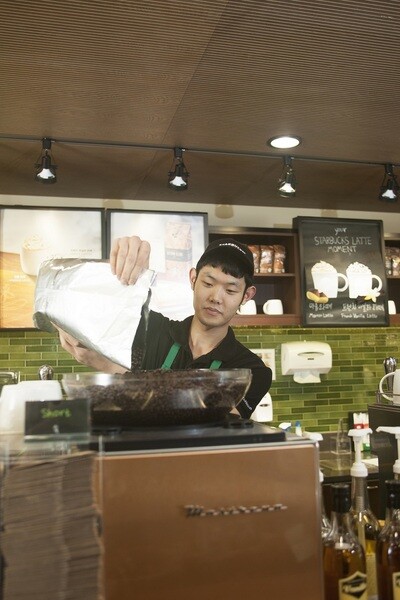hankyoreh
Links to other country sites 다른 나라 사이트 링크
Starbucks taking lead in hiring disabled workers as baristas

“Welcome to Starbucks!”
It’s a common greeting encountered by customers entering the coffee shop. But for Kim Gyeong-ho, a supervisor at the Gimpo Janggi Starbucks, even this simple greeting was a challenge, a homework assignment the 27-year-old had to practice hundreds of times a day. Kim, who has a severe Level 2 hearing impairment, went to work at a printer company, an interiors company, and a baking school in search of a job that was both stable and suited to him. He earned certifications in wallpaper, baking, and coffee serving. But in a society where prejudice against disabled people is strong, he found it difficult to achieve his dream.
In Mar. 2014, Kim began procedures for Starbucks Korea’s disabled barista hiring program. Within a year or so of starting work, he had become a supervisor overseeing his store and other employees.
“I enjoy brewing coffee, but what’s been even more enjoyable for me is talking to customers,” he said. “Early on, there were a lot of misunderstandings when I couldn’t understand what the customer was saying, but over time I started to read their lips, their eyes and expressions, and I was able to have conversations with them.”
“Now there are regulars who speak slowly so I can understand or write things down on paper for me,” he added.
Starbucks Korea first began its disabled barista hiring program in 2007. Since 2011, it has worked with the Korea Employment Agency for the Disabled (KEAD), hiring over 50 disabled baristas each year. Candidates are selected for five weeks of training and practice before being sent into the stores. Currently, there are 163 disabled people working at Starbucks branches across South Korea. 22 of them have earned promotion to manager level.
Olympic Park Nammun deputy store manager Kwon Sun-mi, 38, also has a hearing impairment. Other disabled employees served as role models as she progressed from joining as one of the first disabled baristas hired in 2011 to reaching her current position in 2015. At more and more stores, disabled employees like Kim and Kwon are taking orders directly from customers.
As of 2016, Starbucks had a disabled person employment rate of 2.9%. This year’s group of 50 will bring the total up to 3%. Compared against the newly raised 2.9% mandatory private and public employment rate for 2017, the number is not that high. But 3% is nothing to sniff at in a climate where the disabled person employment rate in service positions remains less than 1% (0.88% as of 2015).
Starbucks adopts a “three nos” approach to hiring: no gender discrimination, no discrimination in terms of severity of symptoms, and no discrimination by disability type. Women account for 70% of all disabled employees at the moment, and severely disabled persons for 78%.
Now Starbucks Korea is moving beyond hiring to focus on job adaptation and employment security. Park Jong-hwan, an employee with the company’s Partner Happiness Team, spends four days a week visiting stores to talk to disabled baristas.
“Most of the employees have relatively little experience with community life, so lot of them have been hurt by customer attitudes or feel like they can’t adapt on their own,” Park said.
“The breaking down of boundaries between disabled and non-disabled employees and the improvement of perceptions are big sources of support for them,” he added.
By Kim Eun-hyoung, staff reporter
Please direct questions or comments to [english@hani.co.kr]

Editorial・opinion
![[Column] Park Geun-hye déjà vu in Yoon Suk-yeol [Column] Park Geun-hye déjà vu in Yoon Suk-yeol](https://flexible.img.hani.co.kr/flexible/normal/500/300/imgdb/original/2024/0424/651713945113788.jpg) [Column] Park Geun-hye déjà vu in Yoon Suk-yeol
[Column] Park Geun-hye déjà vu in Yoon Suk-yeol![[Editorial] New weight of N. Korea’s nuclear threats makes dialogue all the more urgent [Editorial] New weight of N. Korea’s nuclear threats makes dialogue all the more urgent](https://flexible.img.hani.co.kr/flexible/normal/500/300/imgdb/original/2024/0424/7317139454662664.jpg) [Editorial] New weight of N. Korea’s nuclear threats makes dialogue all the more urgent
[Editorial] New weight of N. Korea’s nuclear threats makes dialogue all the more urgent- [Guest essay] The real reason Korea’s new right wants to dub Rhee a founding father
- [Column] ‘Choson’: Is it time we start referring to N. Korea in its own terms?
- [Editorial] Japan’s rewriting of history with Korea has gone too far
- [Column] The president’s questionable capacity for dialogue
- [Column] Are chaebol firms just pizza pies for families to divvy up as they please?
- [Column] Has Korea, too, crossed the Rubicon on China?
- [Correspondent’s column] In Japan’s alliance with US, echoes of its past alliances with UK
- [Editorial] Does Yoon think the Korean public is wrong?
Most viewed articles
- 1‘We must say no’: Seoul defense chief on Korean, USFK involvement in hypothetical Taiwan crisis
- 2Will NewJeans end up collateral damage in internal feud at K-pop juggernaut Hybe?
- 3[Column] Park Geun-hye déjà vu in Yoon Suk-yeol
- 4Why Korea shouldn’t welcome Japan’s newly beefed up defense cooperation with US
- 5Thursday to mark start of resignations by senior doctors amid standoff with government
- 6N. Korean hackers breached 10 defense contractors in South for months, police say
- 7[Guest essay] The real reason Korea’s new right wants to dub Rhee a founding father
- 8[Column] ‘Choson’: Is it time we start referring to N. Korea in its own terms?
- 9Kim Jong-un expressed ‘satisfaction’ with nuclear counterstrike drill directed at South
- 10[Editorial] New weight of N. Korea’s nuclear threats makes dialogue all the more urgent